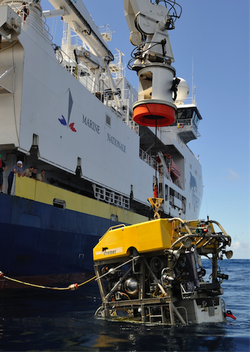
The 107-metre long Pourquoi Pas ? is an offshore vessel of the French oceanographic fleet operated by Ifremer and Shom. It is capable of operating two underwater systems at the same time and can accommodate up to 40 scientists and technicians in addition to the crew (20-30 sailors).
Pourquoi pas ? in 2010
©Ifremer
The ROV (Remotely Operated underwater Vehicle) Victor 6000 is a robot remotely operated from the ship. Equipped with cameras and arms, it can study the ocean floor and sample rocks and sediments. A fibre optic cable allows the transmission of data and energy for dives lasting up to 3 days.
Launching of VICTOR from the Pourquoi Pas ?
during the ODEMAR campaign in 2013
©IFREMER/CNRS/IPGP

The IdefX AUV (Autonomous Underwater Vehicle) is an autonomous underwater robot that can fly between 25 and 50 m from the ocean floor. It is equipped with a multi-beam acoustic sensor to make high-resolution maps of the seabed. It can also measure the physical and chemical properties of the water to detect signals of hydrothermal activity.

AsterX during the Bathyluck 2008 oceanographic campaign
©IFREMER/CNRS/IPGP
Deployed in a network on the ocean floor, BroadBand Ocean-Bottom Seismometers (BBOBSs) characterise the velocity structure of the lithosphere from their recordings of seismic signals. They also provide data for AUV navigation.
Recovery of a BBOBS from the IPGP/CRNS instrument pool
©IFREMER/CNRS/IPGP
